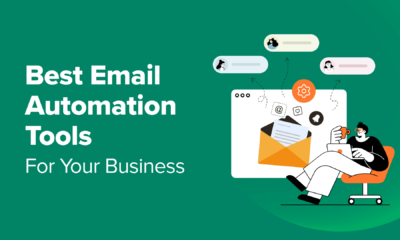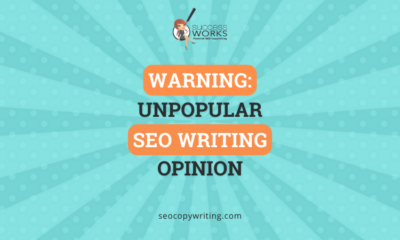MARKETING
PPC In 2020: 2 Experts Weigh In On Future Trends [Video]
Within our daily work lives at Hanapin, we have so many interesting PPC discussions across desk pods, at lunch, or through video chats. To be a fly on the wall for those conversations would be an informative experience! We want to bring some of those fascinating conversations to PPC Hero for our readers.
In this video, Hanapin’s Dani Gonzales and John Williams discuss the future of PPC and what’s on their wishlists for 2020.
Transcription
Dani:
Today we’re going to chat about the future of PPC. I’m joined by my coworker John Williams and before we fully dive in here we’ll go ahead and introduce ourselves.
I am a senior account manager here at Hanapin and I focus a lot on led gen campaigns particularly in B2B verticals, and I’m excited to share some fun stuff today.
John:
I’m John. I’ve been around for about 10 years in the digital industry and with Hanapin since July, which was a dream for me. I love everything whether it’s tag management, analytics, or paid search.
Dani:
You’ve been in the industry over 10 years, over that time what trends have surprised you the most in PPC?
John:
You can probably talk about the difference between using a PC or a Mac now and looking at an ad or you can talk about Google my business listings, or the 3-pack. There’s a lot that you can talk about, but for me, the absolute biggest has probably been attribution. We’ve always talked about it, but we didn’t really know what it was. Is it linear, is it time decay? Is a customer at the top of the funnel, are they at the bottom of the funnel? I think all of that’s out the door. I think we have to start looking at it a different way and I think a lot of the products that we’re using today are saying, look customers are over here on the left, and then on the top, and then they’re down here at the bottom. I think that’s the biggest for me is that the biggest change has been the progression of attribution and the technology behind it.
Dani:
I have to agree a little bit on the technology side.
So I’ve been in the industry less time than you just over three and a half years now and I think the thing that continually surprises me is that more and more we have access to so much data; audience data, demographic data, tons of micro bits of data, but we still struggle to report accurately across all the different data points we have from merging our client CRM data with what we’re seeing in the platform’s themselves. So I think that’s the one thing that I’m continually flummoxed by is how is it possible that we don’t have a really great source of truth for all of this information. Of course, I’m aware of the myriad of ad reporting software that’s available, but at the same time, it’s still something that I think is really surprising to me.
When you look ahead to 2020, is there anything that particularly excites you in the world of PPC? Any particular trends, features, consumer information – anything that you’re excited about?
John:
Yes, and no. I’m not really excited about all of the changes that are coming here to the US that means that as advertisers were going to start to see a lot of lot more propaganda on LinkedIn and Twitter about how something should be implemented or these leads aren’t really valid or are you doing this? So that doesn’t excite me.
What does excite me is that we’re learning how to be smarter advertisers. Meaning we’re asking better questions about our data from a strategy perspective. Everybody’s got an answer, everybody’s right. But you can’t always be right and I think we’re now starting to realize that as marketers, not just digital advertisers, that we need an objective that should be followed up with a strategy that helps us with the tactic.
Google’s walking along with us and so is Microsoft and our other partners that we have; they’re saying, stop doing all of the tactics in the day-to-day and start focusing on the things that actually matter. So that’s what excites me about going into 2020, I think we’ll see a lot more of that.
Dani:
My excitement goes along a similar trendline in terms of the automation features that we have available across managing all of our platforms. We can really hone in on the creative piece and focus on strategy and focus on the things that I think are really going to matter in 2020. Moving beyond, as all of these platforms get a lot more automated and we’re kind of letting go of the reins, there’s a couple of key pieces that we’re going to have to maintain really tight control of, and for me that’s creative and landing pages.
That’s going to be the place as advertisers we’re really going to be able to make a mark for our clients or if you’re doing your own digital advertising make a mark for yourself. I think really focusing on the creative components and the landing page experience is going to be a huge bit of what is going to make advertisers successful in 2020.
John:
Do you want to learn markup in HTML?
Dani:
No, I don’t know who wants to learn that but again, if it’s going to be a key component of helping our clients be more successful or at least being able to venture into the world of CRO and really get some solid multivariate testing on what’s going to work on landing pages for those individual clients. I don’t think we have to necessarily learn that ourselves as long as we have developers in our corner working on that and providing really strong testing results.
Again, I think the landing page experience is going to be a huge part of 2020 and we’ve seen that of course throughout the last few years with mobile AMP pages and all kinds of different landing page experiences. I think CRO is going to play a much larger role or we’re going to have to give it more credit than we may historically have.
If you could get Google and/or Facebook to make one huge update in 2020, what would it be?
John:
The biggest thing would probably be in Google. I love scripts, I want to learn JavaScript and python, I want to spend all my time doing that, but Google already has rules. So Google if you’re listening, you have rules. They function every 24 hours, can you just adjust it so that we can implement that every 12 hours? I would take that, but I would love to see the biggest change being rules changed to hourly so that we can start to work on things that matter for our clients and stop worrying about if we’re going to go over by 10% or worrying about coming up with a script that we need to calculate at 30% over or 30% under. Can we just get over that and utilize your tool and what you built it for?
Dani:
My number one wish list item, this comes up a lot especially again kind of coming back to the theme of automation and the more we implement automated pieces, we need data to make that possible. So we’re looking at the future of conversions. What does that look like? Do we start implementing micro-conversions so that we can get more data so those algorithms can be more powerful and we can use more of that machine learning? But within doing that, how we’re kind of rethinking what a conversion is and how we calculate this measure of success, I would really love if Google would just show me the corresponding data metrics with my conversion actions. Currently, if you have multiple conversion actions live in an account you can’t see the corresponding impressions, clicks, spend that was associated with those conversion actions. You can see the total and that’s it. So Google people if you are listening, please let me see key metrics alongside my conversion actions. It’s so little and I know you know it, and I know you have this information.
John:
You have to, you’re showing it in Google Analytics, so come on, give it to us. Just put it in one place. Why do we have to go to three places to look for things? One place, yes please.
Dani:
Anything else on your PPC wish list?
John:
It’d be great if we just had one tool. We have to go to too many places for reporting, for measurements, and then to take action. And we can’t afford it. Not everybody can afford an Adobe stack or Google marketing platforms. We can’t afford that and we shouldn’t have to use a third-party tool that interjects into our account to provide us with suggestions. It would be great if we had one tool that you can go in and see everything and do everything.
Dani:
To recap we want fewer tools overall, better tracking, and what was yours? More data analytics?
John:
The tracking, the measurements, and the tactic.
Dani:
And merging all of that into a cohesive story for your client is also pretty hard when you have to implement all of the different data points from all of the different platforms, which may or may not have similar attribution. You’re kind of running in a circle trying to present a really strong story that backs up your data, but then it’s really hard to plug it all in, get it centralized, and have it make sense in a way that’s really palatable.
John:
If it was your last ornament, what would that be? What would that last little thing that you wanted to like cap off your tree with for the holidays?
Dani:
I guess less from a platform perspective, but I want more of my clients doing video, higher quality video and focusing more on that. We’ve seen for some of my clients some really impressive brand lifts as a result. I think the better quality targeting that we’ve had in YouTube over the past year and some of the new capabilities like custom intent are really cool. I think that’s where I’d like to see that little ornament. A little shiny cherry on top would be just more video coming down from for my clients in particular.
John:
I like it. It takes a lot of work, but it is the brand appeal and how we’re moving away from TV and how we’re looking at the social components of things – it is 3 to 6-second bursts.
Dani:
I’m always troubled by clients being wary of YouTube or not wanting to run YouTube ads. For decades you were okay running TV ads when you have no idea who you’re targeting per se. We have so much more data we can get a lot more localized we can get a lot more segmented and that scares clients. I think it’s kind of funny reverse logic there. But I’m a big fan of YouTube, a big fan of running ads in that platform, especially given a lot of its more recent improvements.
Thanks again for listening everyone and we hope you join us again.


















